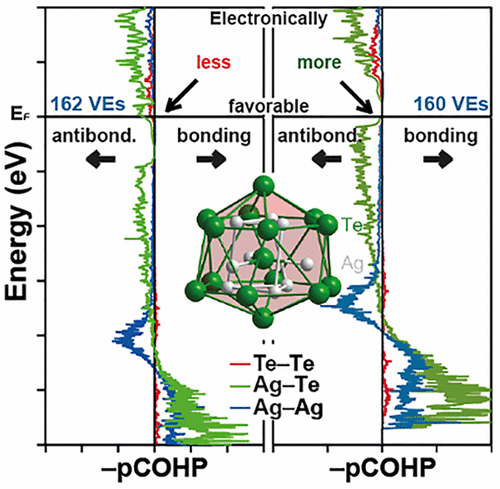当前位置:
X-MOL 学术
›
Inorg. Chem.
›
论文详情
Our official English website, www.x-mol.net, welcomes your
feedback! (Note: you will need to create a separate account there.)
The Mineral Stützite: a Zintl-Phase or Polar Intermetallic? A Case Study Using Experimental and Quantum-Chemical Techniques
Inorganic Chemistry ( IF 4.3 ) Pub Date : 2017-12-18 00:00:00 , DOI: 10.1021/acs.inorgchem.7b02642 Kai C. Göbgen 1 , Fabian C. Gladisch 1 , Simon Steinberg 1
Inorganic Chemistry ( IF 4.3 ) Pub Date : 2017-12-18 00:00:00 , DOI: 10.1021/acs.inorgchem.7b02642 Kai C. Göbgen 1 , Fabian C. Gladisch 1 , Simon Steinberg 1
Affiliation

|
Differing reports regarding the structural features of the mineral stützite, Ag5–xTe3 (−0.25 ≤ x ≤ 1.44), and the quest for tellurides with low-dimensional fragments stimulated our impetus to review this system by employing experimental as well as quantum-chemical methods. Determination of the crystal structures for three samples with compositions Ag4.72(3)Te3 (I), Ag4.66(1)Te3 (II), and Ag4.96(2)Te3 (III) revealed considerable positional disorders for the Ag and Te sites and previously unknown structure models for I and II, which differ from that of III through the stacking sequences of honeycomb-fashioned Te layers. The crystal structures comprise [[email protected]9]@Te14 units in the forms of bicapped hexagonal Te antiprisms that enclose Te-centered tricapped trigonal Ag prisms, while each Te atom is encapsulated by Ag atoms assembling diverse types of coordination polyhedra. The vibrational and electronic properties were determined for three models approximating the actual crystal structure of stützite by means of techniques based on first principles. From analyses of the electronic structures and projected crystal orbital Hamilton populations (pCOHP), it is clear that the amounts and distributions of the Ag atoms within the Te network should be influenced by the subtle interplay between the attempts to achieve an electronically favorable situation with a gap at EF and minimize the occupations of antibonding states.
中文翻译:

矿物辉石:Zintl相还是极性金属间化合物?使用实验和量子化学技术的案例研究
关于矿物stützite,的结构特征不同的报告的Ag 5- X碲3(-0.25≤ X ≤1.44),以及用于与低维片段刺激我们的动力通过采用实验以及量子评论此系统碲化物的追求-化学方法。对三个组成为Ag 4.72(3) Te 3(I),Ag 4.66(1) Te 3(II)和Ag 4.96(2) Te 3(III)的样品的晶体结构的测定表明,Ag的位置不均匀和Te站点以及以前未知的结构模型I和II与III的不同之处在于蜂窝状Te层的堆叠顺序。晶体结构包括[[受电子邮件保护] 9 ] @Te 14二元六边形Te反棱镜形式的单元,包围着以Te为中心的三棱三角形Ag棱镜,而每个Te原子都被Ag原子包封,从而组装了各种类型的配位多面体。通过基于第一原理的技术,确定了三种模型的振动和电子性能,这些模型近似于实际的斯特氏体晶体结构。通过对电子结构和预测的晶体轨道汉密尔顿人口(pCOHP)的分析,可以清楚地看出,Te网络中Ag原子的数量和分布应受试图实现电子有利态的微妙相互作用的影响。E F处的间隙,并最小化反键态的占据。
更新日期:2017-12-18
中文翻译:

矿物辉石:Zintl相还是极性金属间化合物?使用实验和量子化学技术的案例研究
关于矿物stützite,的结构特征不同的报告的Ag 5- X碲3(-0.25≤ X ≤1.44),以及用于与低维片段刺激我们的动力通过采用实验以及量子评论此系统碲化物的追求-化学方法。对三个组成为Ag 4.72(3) Te 3(I),Ag 4.66(1) Te 3(II)和Ag 4.96(2) Te 3(III)的样品的晶体结构的测定表明,Ag的位置不均匀和Te站点以及以前未知的结构模型I和II与III的不同之处在于蜂窝状Te层的堆叠顺序。晶体结构包括[[受电子邮件保护] 9 ] @Te 14二元六边形Te反棱镜形式的单元,包围着以Te为中心的三棱三角形Ag棱镜,而每个Te原子都被Ag原子包封,从而组装了各种类型的配位多面体。通过基于第一原理的技术,确定了三种模型的振动和电子性能,这些模型近似于实际的斯特氏体晶体结构。通过对电子结构和预测的晶体轨道汉密尔顿人口(pCOHP)的分析,可以清楚地看出,Te网络中Ag原子的数量和分布应受试图实现电子有利态的微妙相互作用的影响。E F处的间隙,并最小化反键态的占据。
















































 京公网安备 11010802027423号
京公网安备 11010802027423号